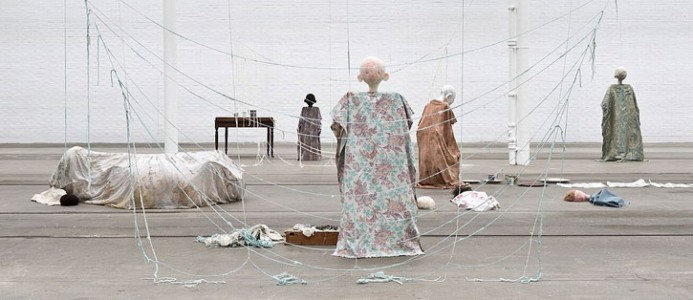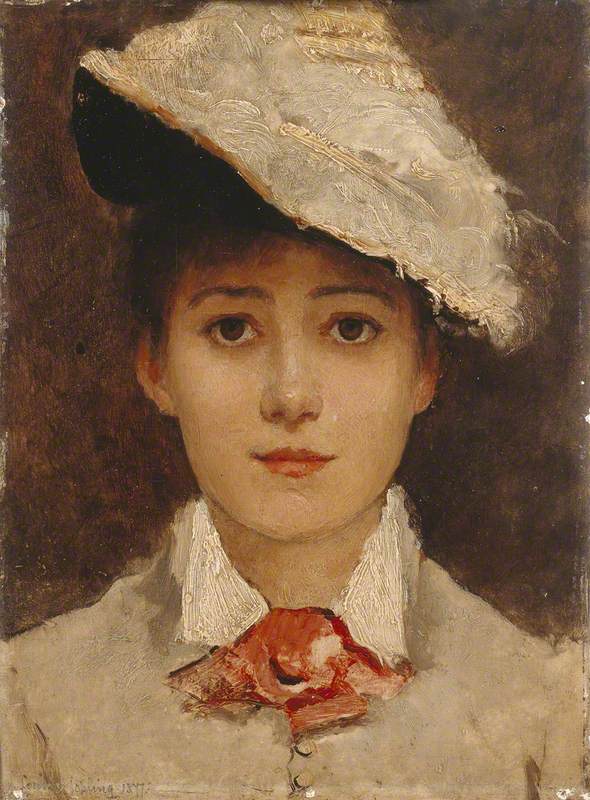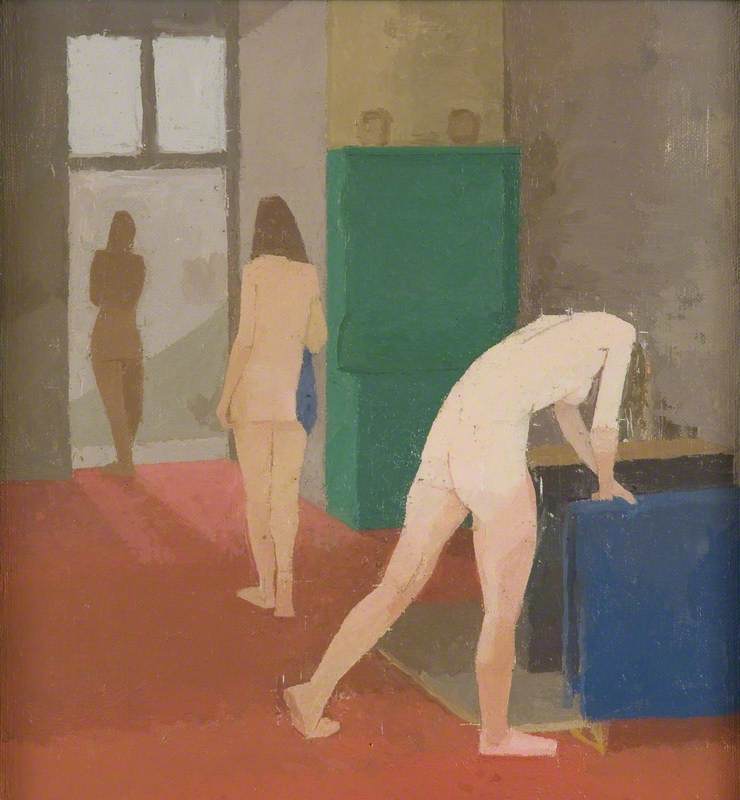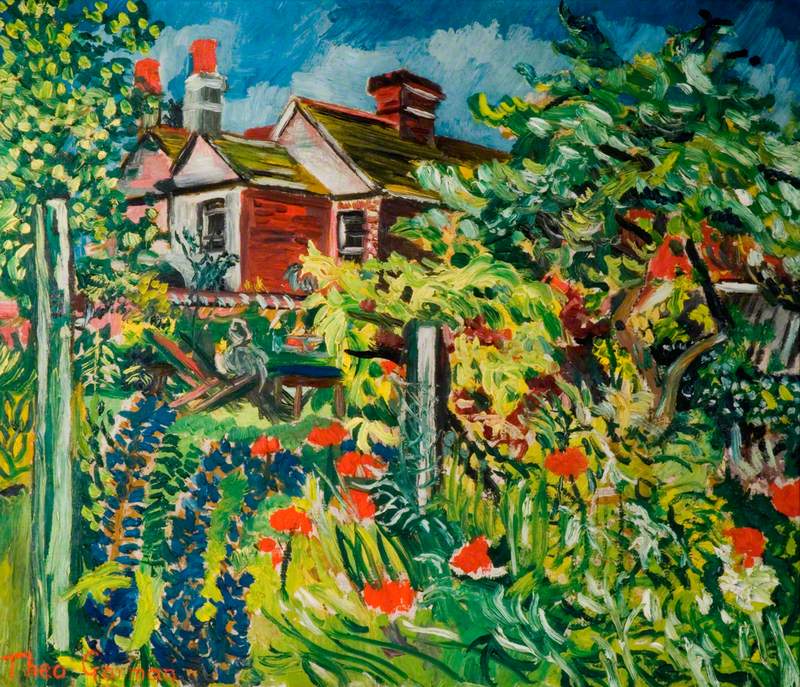A chandelier comprised from a cascade of coarse black ribbons, a wall hanging made of twists of iridescent plastic foil. Substantial sculptures made from wood, rope, brass, and stainless steel. Linen and gold leaf plaited together and interweaved. Sheets of metal that are folded or curved into spirals. Puddles of multicoloured latex and waxy lozenge shapes.
'Making It: Women and Abstract Sculpture', a group exhibition organised by Waddington Custot in London, presents a generation of pioneering modern and contemporary women sculptors, showing work by Olga de Amaral, Lynda Benglis, Françoise Grossen, Maren Hassinger, Barbara Levittoux-Świderska, Louise Nevelson, Beverly Pepper, Mildred Thompson, and Sophia Vari.
Sophia Vari in her studio
These artists, the majority of whom came to note in the late 1960s and early 1970s, have been brought together due to their mutual interests in working ambitiously with scale and experimenting with unorthodox materials.
Sculpture had been broadly considered the purveyance of male artists, due to skewed misogynistic notions regarding the relationship between masculinity, strength, and traditional forms of fabrication. In response, often due to their difficulties accessing male-dominated foundries and wood workshops, women became engaged with unconventional media and techniques. Their collective perseverance intersected with the historical quest for women's liberation, notably how the second-wave feminist movement pushed for recognition and equality for women artists.
White Drops [Biale krople]
1970, plastic foil & sisal by Barbara Levittoux-Świderska ![White Drops [Biale krople]](https://d3d00swyhr67nd.cloudfront.net/_source/artuk_stories/barbara-levittoux-swiderska-725px-1.jpg)
Olga de Amaral
Olga de Amaral's practice blurs the lines between art, craft, and design. Living in Paris in the 1970s, she began experimenting with natural materials, developing her own hand-made techniques and utilising raw wool, branches, and horsehair.
Manto de greda [Clay Mantle]
1977, wood & horsehair suspended on wood by Olga de Amaral ![Manto de greda [Clay Mantle]](https://d3d00swyhr67nd.cloudfront.net/_source/artuk_stories/olga-de-amaral-725px-1.jpg)
Her large-scale textile-based works typically take the appearance of wall hangings, often hung from the ceiling in order to shift the spatial register of their viewing environment. These woven canvases, comprised of linen and cotton, are also bolstered by applying gesso or acrylic paint.
The lustrous Alchemy 50 (1987) is part of the wider Alchemic series. She began using gold leaf after the ceramic artist Lucie Rie had introduced her to the Japanese practice of kintsugi (the art of using gold leaf to repair the cracks in pottery) in the 1970s.
Lynda Benglis
Lynda Benglis moved to New York in 1964, after studying ceramics and painting in New Orleans. Her sculptural practice came from a desire to break away from the restrictions of formal painting, querying its limitations and pushing its boundaries. 'I wasn't breaking away from painting but trying to redefine what it was,' she said.
In the late 1960s, she became known for her wax reliefs in the shape of lozenges, in addition to her poured latex works, in which liquid rubber in lurid colours was applied directly to the floor, creating pools and spillages of variegated colours and textures. These took the field of painting into a three-dimensional space, and wryly riffed on Jackson Pollock's drip technique. Benglis also made sculptures from layers of polyurethane foam.
Later, as with Quartered Meteor (1969, cast 1975), she began casting these forms in more durable and long-lasting materials, such as lead, as a way of preserving and subverting their original ephemerality.
Maren Hassinger
Maren Hassinger initially trained as a dancer, but shifted her focus to sculpture during her studies at Bennington College, Vermont in the late 1960s. After living briefly in New York, she returned to Los Angeles to pursue an MFA in fibre materials at the University of California.
Installation View, Twelve Trees, Los Angeles, CA
1978, photograph by Adam Avila 
While her multidisciplinary practice spans numerous mediums, she is particularly known for the enduring use of steel wire rope in her work. Associated with the poetic, expressive gestures common to post-minimalist sculpture, her interest in the material was initially grounded in its malleability, particularly its ability to mimic natural forms, such as hair, tree vines, and water ripples.
Untitled Vessel (Small Body)
2021, stainless steel wire rope on steel armature by Maren Hassinger 
The contrast between the manmade and natural world is important to Hassinger, who has also incorporated salvaged and organic materials, such as pink plastic bags, large tree branches, dirt, leaves, and woven newspapers into her creations.
Louise Nevelson
Like Benglis, Louise Nevelson started her career as a painter, but then moved into sculpture, working with bronze, terracotta and marble. In the mid-1950s, she began making the type of work for which she is best known: painted constructions comprised of recycled junk found on the streets.
Portrait of Louise Nevelson, 1968
Sky City I (1957–1959) is a prime example of this, with Nevelson creating a shrine-like assemblage out of discarded wooden boxes and objects, all uniformly covered in her obsidian black paint. While Nevelson was resistant to women artists being siloed, in her book Tate Women Artists, Alicia Foster writes about how the artist had claimed that 'her sex made her work essentially different, writing that her use of wood, with its domestic associations, was "perhaps closer to the feminine".'
Sky City I
1957–1959, wood painted black by Louise Nevelson 
Nevelson had argued: 'A man simply couldn't use of the means of, say, fingerwork to produce my small pieces. They are like needlework. My work... may look strong, but is delicate... My whole life is in it, and my whole life is feminine.'
Mildred Thompson
Mildred Thompson was born in Jacksonville, Florida, but spent the majority of her career living abroad due to the racism and sexism she had faced in the United States. Moving to Germany in 1964, she found there were greater possibilities for African-American artists in Europe, after an intense period of difficulty seeking commercial representation or exhibition opportunities in New York.
Mildred Thompson with a free-standing wood assemblage in late 1970s
Thompson favoured abstraction, eschewing any narrative subject matter, and creating paintings, drawings, and sculpture throughout her prolific career. Her free-standing wooden assemblages and sculptures were comprised of wood she sourced in German forests that she combined with machine-cut wooden segments.
Untitled, from the Vespers Series
mid-1990s, wood sculpture by Mildred Thompson 
Akin to Hassinger, she was engaged in contrasting the natural with the manufactured. Critics have commented on how some of these sculptures are also shaped like abstracted versions of musical instruments, a reflection on how Thompson was also a trained musician.
Sophia Vari
'What I look for is to take geometry, volume and form, to humanise it in space,' the Greek artist Sophia Vari has said of her practice. Her sculptural work is influenced by numerous historic artistic traditions, ranging from Mayan and Egyptian to the ancient and Baroque.
Le matin du monde
2019, marble sculpture by Sophia Vari 
The white marble sculpture Le Matin du Monde (2019) and the bronze Lumière Volcanique (2019) exemplify her use of geometric form, curves, and monochrome colour, which has been intrinsic throughout her career.
Lumière volcanique
2019, bronze sculpture by Sophia Vari 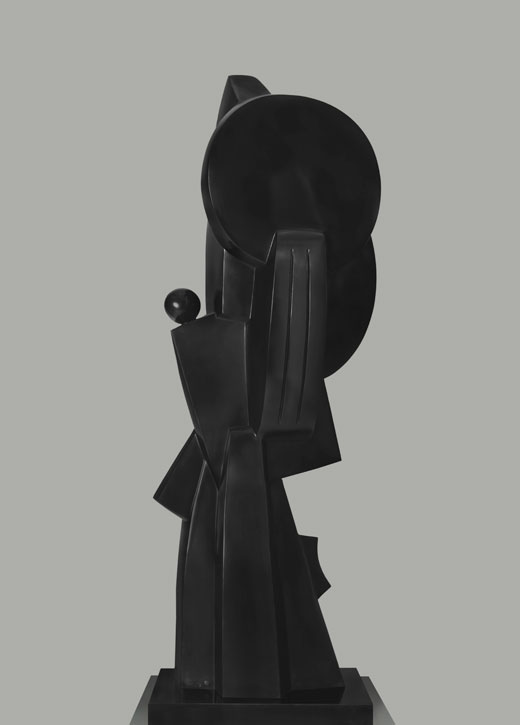
Interested in the monumental, Vari has made numerous public sculptures, which are often accented with bold primary colours, using blue, red, and yellow paint to create a playful contrast with the patina surfaces.
Philomena Epps, writer













